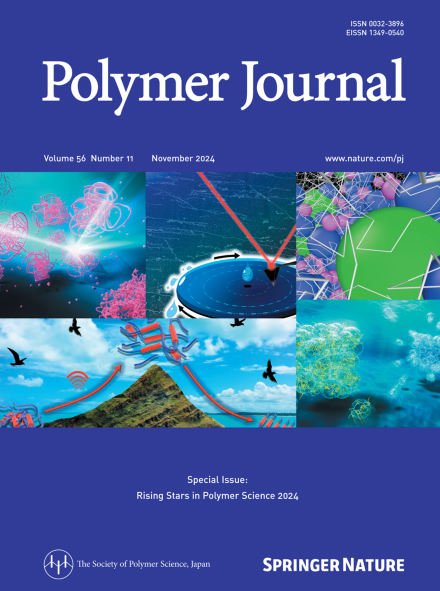非对称聚合物刷饰纤维素纳米晶体的合成与二维有序
IF 2.3
4区 化学
Q3 POLYMER SCIENCE
引用次数: 0
摘要
棒状纤维素纳米晶体(CNCs)通常是通过水解纤维素纳米纤维得到的,纤维素纳米纤维在其还原端具有甲酰基。在本研究中,我们制备了承载不同分子量高密度接枝聚合物刷的cnc(不对称聚合物刷装饰的cnc;aPB-CNCs)。apb - cnc在有机溶剂中表现出良好的分散性,并在空气/水界面形成单层。这种单层的压缩引起了还原端长聚合物刷的相变,并且由于排斥相互作用而改变了CNC芯的方向。CNC被认为是一个关键的中间体,分别在还原端和其他表面具有可逆加成-碎片聚合和原子转移自由基聚合的休眠片段(双功能休眠CNC)。这种功能性CNC促进了广泛的单体聚合,并使合成具有不同化学性质的apb -CNC成为可能。所建立的合成路线不仅为探索纳米颗粒的有序结构提供了基础,而且对cnc的还原端进行修饰也很有用。承载不同分子量密集接枝聚合物刷的纤维素纳米晶体(不对称聚合物刷修饰的纳米晶体);apb -CNC)是通过CNC中间体合成的,该中间体具有两种类型的休眠基团,分别在还原端和其他表面进行可控自由基聚合。apb - cnc在有机溶剂中表现出良好的分散性,并在空气/水界面形成单层。这种单层的压缩引起了还原端长聚合物刷的相变,并且由于排斥相互作用而改变了CNC芯的方向。本文章由计算机程序翻译,如有差异,请以英文原文为准。

Synthesis and two-dimensional ordering of asymmetrically polymer–brush–decorated cellulose nanocrystals
Rod-shaped cellulose nanocrystals (CNCs) are typically obtained by hydrolyzing cellulose nanofibers bearing an formyl group at their reducing end. In this study, we prepare CNCs bearing densely grafted polymer brushes of different molecular weights (asymmetrically polymer-brush–decorated CNCs; aPB-CNCs). aPB-CNCs exhibit good dispersion in organic solvents and form a monolayer at the air/water interface. The compression of this monolayer induces a phase transition of a long polymer brush at the reducing end and a change in the orientation of the CNC core due to repulsive interactions. A CNC is identified as a key intermediate, possessing dormant moieties for reversible addition–fragmentation polymerization and atom transfer radical polymerization at the reducing end and other surfaces, respectively (bifunctional dormant CNC). This functional CNC facilitates the polymerization of a wide range of monomers and enables the synthesis of aPB-CNCs with diverse chemical properties. The developed synthetic route not only provides a basis for exploring the ordered structure of nanoparticles but is also useful for modifying the reducing ends of CNCs. Cellulose nanocrystals (CNCs) bearing densely grafted polymer brushes of different molecular weights (asymmetrically polymer-brush–decorated CNCs; aPB-CNCs) were synthesized via a CNC intermediate possessing two types of dormant moieties for controlled radical polymerization at the reducing end and other surfaces, respectively. The aPB-CNCs exhibited good dispersion in organic solvents and form a monolayer at the air/water interface. The compression of this monolayer induced a phase transition of a long polymer brush at the reducing end and a change in the orientation of the CNC core due to repulsive interactions.
求助全文
通过发布文献求助,成功后即可免费获取论文全文。
去求助
来源期刊

Polymer Journal
化学-高分子科学
CiteScore
5.60
自引率
7.10%
发文量
131
审稿时长
2.5 months
期刊介绍:
Polymer Journal promotes research from all aspects of polymer science from anywhere in the world and aims to provide an integrated platform for scientific communication that assists the advancement of polymer science and related fields. The journal publishes Original Articles, Notes, Short Communications and Reviews.
Subject areas and topics of particular interest within the journal''s scope include, but are not limited to, those listed below:
Polymer synthesis and reactions
Polymer structures
Physical properties of polymers
Polymer surface and interfaces
Functional polymers
Supramolecular polymers
Self-assembled materials
Biopolymers and bio-related polymer materials
Polymer engineering.
 求助内容:
求助内容: 应助结果提醒方式:
应助结果提醒方式:


